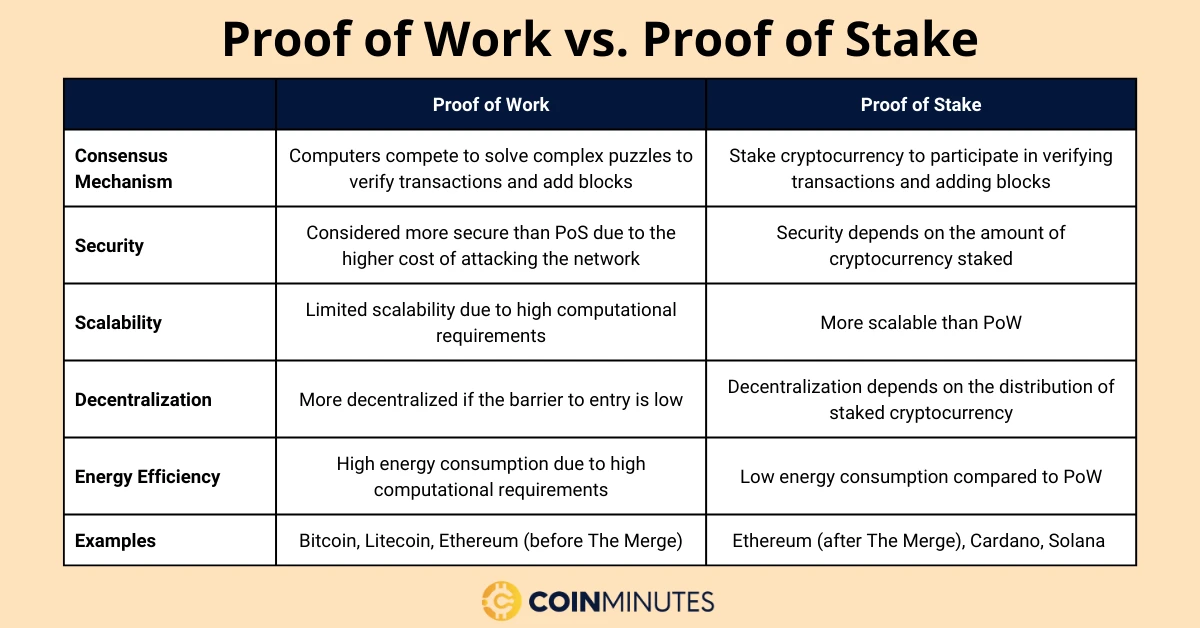What Is Proof of Work?
Proof of Work (PoW) is a consensus mechanism used in blockchain systems, where miners compete to verify transactions and create new blocks.
When users want to transfer tokens on a Proof of Work blockchain, the system utilizes a decentralized ledger to record transactions into a specific block. This process, known as “mining” a block, requires solving a complex mathematical equation, a task undertaken by miners to ensure the security and transparency of the network.
PoW first appeared in a 1993 paper titled “Pricing via Processing or Combatting Junk Mail” by Cynthia Dwork and Moni Naor. They described PoW as a mechanism to prevent denial-of-service (DoS) attacks and limit spam. The basic idea was to require the sender to perform a certain amount of computational work before their request is accepted, thus reducing the likelihood of large-scale attacks or mass spam.
Proof of Work is crucial in blockchains like Bitcoin and Ethereum, helping to verify transactions through complex calculations and adding new blocks to the chain. However, this process is energy-intensive and slow due to the extensive computational work required to solve complex mathematical puzzles. Alternative solutions like Proof of Stake are being researched to improve efficiency and reduce environmental impact.
Key Takeaways
|
Purpose of Proof of Work
Proof of Work serves several important purposes in blockchain technology, ensuring the security and smooth operation of digital ledgers:
- Transaction security: PoW acts as a robust security mechanism by requiring miners to solve complex mathematical problems. This process, called hashing, helps create a unique cryptographic signature for each transaction. Verifying this signature confirms the legitimacy of the transaction and prevents fraudulent activities such as double-spending. It’s like having an anti-counterfeit receipt for every transaction on the blockchain.
- Maintaining decentralization: PoW distributes power within the blockchain network. Unlike centralized systems with a single authority, PoW empowers anyone with the computational ability to become a miner. These miners compete to solve PoW puzzles and add new blocks to the blockchain. This competition makes it difficult for any entity to gain control and manipulate the network.
- Facilitating consensus: By solving PoW puzzles, miners authenticate transactions and reach a consensus on the current state of the blockchain. This consensus ensures that everyone on the network maintains the same version of the distributed ledger, preventing inconsistency and data tampering.
- Rewarding miners: PoW incentivizes miners to participate in securing the network. By successfully solving puzzles and adding blocks, miners earn rewards in cryptocurrency. This reward system continuously encourages the verification and maintenance of the network and ensures its smooth operation.
How Does Proof of Work Work?
Proof of Work (PoW) is a popular consensus algorithm in blockchain networks, ensuring the validity of transactions. Miners in the network compete to solve complex puzzles to verify transactions. The first solver receives a reward in the form of new coins.
Every cryptocurrency has a blockchain, a public ledger created by transaction blocks. With the PoW mechanism, each transaction block has a specific hash function. To confirm a block, miners must generate a hash function smaller than or equal to the block’s hash value.
To do this, miners use mining equipment to perform calculations quickly, aiming to be the first to verify transactions and receive cryptocurrency rewards.
Pros and Cons of Proof of Work
Pros of Proof of Work
- High Security: PoW plays a crucial role in safeguarding the blockchain network by making any potential attack extremely difficult. The high computational requirement imposes a significant cost and energy investment for hackers to execute a successful attack.
- DoS Attack Protection: PoW protects the network from denial-of-service (DoS) attacks by requiring significant computational resources to validate transactions and add new blocks, making it more time-consuming and difficult for attackers to overwhelm the network with fake requests.
- Decentralization: PoW helps establish a decentralized network, meaning no single entity can control the entire system. Anyone can participate in the mining process and verify transactions without requiring approval from any central authority.
- Resistance to Censorship: PoW provides resistance against transaction censorship because miners are incentivized to verify all valid transactions on the network.
Cons of Proof of Work
- High Energy Consumption: The PoW mining process consumes a significant amount of energy due to high mining costs. It requires specialized computer equipment to process complex algorithms, resulting in expensive hardware and increased energy consumption.
- Slow Transaction Speed: The PoW method can lead to slower transaction processing speeds compared to other consensus mechanisms.
- High Mining Costs: Participating in the PoW mining process requires expensive hardware and energy resources, driving up costs.
- Susceptibility to 51% Attacks: Smaller networks with fewer miners are more vulnerable to 51% attacks, where an entity can gain control of the network’s computational power. However, this becomes more difficult with larger networks like Bitcoin, where the cost to control 51% of the computational power is very high. A 51% attack allows malicious actors to seize control of the network by manipulating transaction confirmations, resulting in scenarios such as double spending and causing significant losses to the network.
Proof of Work vs Proof of Stake

Popular Proof of Work Cryptocurrencies
Proof of Work is a longstanding consensus mechanism used in many cryptocurrencies. Below is a list of some of the most popular PoW cryptocurrencies:
- Bitcoin (BTC): The undisputed king of cryptocurrencies, Bitcoin employs PoW as its core consensus mechanism. It is the first and most valuable cryptocurrency globally, and its success has significantly influenced the adoption of PoW in other projects.
- Litecoin (LTC): Often referred to as the “silver to Bitcoin’s gold,” Litecoin is another prominent PoW cryptocurrency. It aims to provide faster transaction processing times compared to Bitcoin by using a slightly modified PoW algorithm.
- Ethereum Classic (ETC): This cryptocurrency emerged as a hard fork of the Ethereum blockchain after it transitioned to a Proof of Stake (PoS) model. Ethereum Classic continues to use the original PoW consensus mechanism.
- Bitcoin Cash (BCH): Created as a hard fork of Bitcoin, Bitcoin Cash aims to address scalability issues related to the original network. It utilizes a modified PoW algorithm that allows for larger block sizes, enabling faster transaction processing.
- Dogecoin (DOGE): Initially created as a playful cryptocurrency, Dogecoin has gained significant popularity and currently operates on a PoW model. However, there are discussions within the Dogecoin community about the potential transition to a more energy-efficient consensus mechanism in the future.
The Bottom Line
Understanding the Proof of Work mechanism is essential to grasp how blockchain technology ensures security and integrity. As we delve deeper into blockchain applications, the role of mechanisms like Proof of Work becomes increasingly significant. This underscores not only the innovation behind blockchain but also its transformative potential across various industries.








